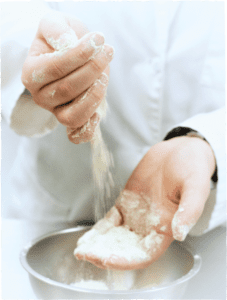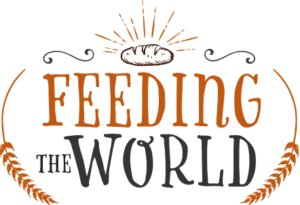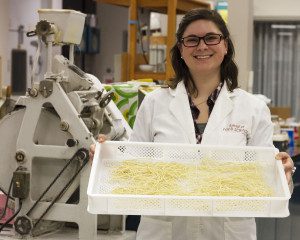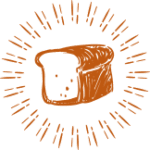Alumna creates bakery goods from new variety of resilient wheat
This is not a GMO. Soft durum wheat is developed by selective cross-breeding, similar to the way dogs were carefully bred to create an Irish setter.
By Lily Raff McCaulou
Jessica Murray ’12 delights in the fact that her favorite pizzeria produces thin crust pizza that is made from a one-of-a-kind flour that is destined to feed the world.
Diners at the Pullman, Wash., shop choose a sauce and toppings as they file along the counter and watch their pizzas get assembled. The pies are slipped into a fiery brick oven for three minutes. When they emerge, the results look like any thin, Italian-style pizzas — slightly charred and crispy on the edges. But the crust — which tears open to reveal a sunny yellow interior — is actually a culinary and scientific breakthrough that could have global ramifications. Many unsuspecting customers don’t even realize they are about to bite into a revolutionary savory pie.
Flour for the dough is ground from a new species of wheat, bred in a United States Department of Agriculture lab just down the street from the pizzeria, and grown at a family-owned organic farm in nearby Idaho.
For Murray, Porch Light Pizza serves up a cheesy, chewy product that her own hands have shaped. The pie also represents a stepping stone on a career path that began at Clark College, which Murray envisions stretching out for decades.
Murray’s academic journey started two years before she arrived at Clark College. At age 15, she enrolled in the Clark County Skills Center, a vocational school in Vancouver. She took the required courses at La Center High School, then spent her afternoons taking culinary classes through the skills center.
“I’ve always loved cooking food for my family,” Murray said, “so I thought it would be fun to have all of my elective classes be related to food.”
That focus on cooking solidified Murray’s dedication to the craft. When she graduated from high school, she enrolled in the Baking program at Clark College. It offered hands-on experience and also bolstered Murray’s scientific understanding of baking.
“Everything in baking is a scientific balance between ingredients, technique and baking effect,” said Alison Dolder, an instructor who taught Murray and is now the interim director of the renamed Professional Baking and Pastry Arts program.
Dolder said that baking can be revelatory to students who, unlike Murray, struggle with chemistry or algebra. A mastery of both subjects is necessary for success in a commercial kitchen, where an extra pinch of one ingredient can throw off chemical reactions and yield a chalky cookie or a soggy soufflé.
“This is the kind of science that can make sense, because they can see it happening right in front of them,” Dolder said.
For the next two quarters however, students will take a break from hands-on experience as the facility is remodeled. The anticipated reopening of the Culinary Institute at Clark College will occur in 2017 and feature entirely new curricula in Cuisine and Professional Baking and Pastry Arts. Modernized equipment will better prepare students for careers in a professional bakery, according to Dolder.
Murray completed the pastry program at Clark and earned an associate of arts in business administration with honors in two years, then transferred to Washington State University in Pullman. Shortly after arriving, she landed a job in the university’s hospitality-catering department. WSU doesn’t have a pastry curriculum, so her pastry training set her apart from her peers. As a member of the catering service’s pastry team, she put both her management and baking skills to use, such as planning menus for catered events. One of the best parts of the job, she said, was that the experience introduced her to a wide variety of people around the university.
On one particular day, Professor Craig Morris lugged a 50-pound sack of flour into the hospitality kitchen where Murray worked. Morris, who runs a USDA wheat lab near the WSU campus, wanted the head chef to experiment with flour ground from a new variety of wheat he had recently developed. The chef was creating recipes for a cookbook—titled Crimson Spoon—that used local ingredients and those with ties to WSU. Murray was assisting him, testing and honing recipes for the book.
Her contributions impressed Morris and landed her a second job as a research assistant in his lab. Meanwhile, Murray earned two degrees — a bachelor’s of arts in Hospitality Business Management and a bachelor’s of science in Food Science. Today she is working toward a master’s in Food Science, also at WSU. Murray’s baking experience, combined with being the only baker in the lab, gives her a unique role.
“Jessica’s research has currently been focusing on what can be done with this newly developed flour,” said Morris. “We know it makes good pasta, but how about hearth bread? Ciabatta? Bakery items?”
 Evolution of wheat
Evolution of wheat
To understand the significance of Morris’s discovery, it helps to understand the evolutionary history of wheat, which involves three main species. The most ancient is einkorn, which refers to single grain in German. That plant can tolerate poor soil and dry weather. Its grain is soft and easy to mill into flour. But einkorn is a low-yielding crop, the grain is difficult to separate from the chaff, and its flour doesn’t have the rising properties that are useful in baking.
Hundreds of thousands of years ago einkorn naturally hybridized, or crossed with another wild grass, to produce a new type of wheat that is now called durum. Durum wheat is a more productive crop and easier to hull than einkorn. But the evolutionary leap resulted in the loss of the genes for kernel softness: durum wheat is very tough and hard to mill. Today, durum is ground into a coarse flour called semolina, commonly used to make pasta and couscous.
Durum again hybridized, this time with a weed that was growing nearby, to form a third species, often referred to as modern bread wheat. When this newer form of wheat evolved, the genes for softness were reintroduced, while several advantages of durum wheat were maintained. This newer species is much pickier about its growing conditions, however.
In his lab, Morris set out to breed a new variety of wheat that combined modern bread wheat’s softness with durum’s ability to thrive in a hot, dry climate. He and his colleagues are quick to point out—in academic papers as well as casual conversation—that their new wheat species isn’t a genetically modified food. Genetically modified organisms, sometimes called GMOs, are a hot-button political issue, as scientists, farmers and consumers dispute the safety of such foods. Even the definition of GMOs is open to some debate.
For researchers like Murray, a GMO food means that it has foreign DNA, or genetic material from an unrelated plant or animal, spliced into its own genome using modern technology. Though GMO wheat is under development in some laboratories — but not Morris’s — there are currently no genetically modified wheats on the market anywhere in the world, according to the Washington Association of Wheat Growers.

Flour for the dough is ground from a new species of wheat that Jessica Murray is experimenting with at WSU in Pullman. Photo by Seth Truscott, WSU CAHNRS.
Murray explains the process she’s involved in this way: the soft durum wheat was developed by selective breeding, similar to the way dogs were carefully bred to create the Irish setter or how roses were propagated to create the American Beauty.
For Professor Morris, soft durum wheat appears to be the scientific achievement of a lifetime.
“It’s actually far exceeded any of our wildest expectations,” he said. “If we just think about durum versus bread wheat, durum has some inherent advantages in dealing with drought, heat, pests—pathogens as well as insects. And so I think, whether you believe the globe is getting warmer or not, there are plenty of places that are already hot and dry where this can be useful.”
The climates in arid Northern Africa and the Middle East, for example, can’t sustain crops of common bread wheat. Durum can thrive. Soft durum opens the possibility of growing wheat in those areas to make not only couscous and pasta, but bread.
“French collaborators have shown that it can take something like one-seventh to one-fourth of the energy to mill (soft durum) as it does durum wheat,” Morris said.
Even if soft durum is used in the same applications as hard durum, the energy savings will add up.
“This could have a huge impact on the food supply in developing areas,” Murray added.
As a commercial pilot trial, the wheat is being farmed on 20 acres in Lewiston, Idaho, where it is also stone ground at a small mill. Since July 2015, this has been the sole source of flour for the pizza crust at Porch Light Pizza. Murray developed the crust recipe and has since helped adjust it, as necessitated by variations in small mill batches.
Murray fully anticipates that this work will impact her future. Once she completes her master’s next year, she will pursue a job in product development.
“Eventually, I’d like to be able to walk into a grocery store and say, I developed that product and now people are buying it,” Murray said.
She would also like to take what she is learning about farm-to-fork eating—or, rather, lab-to-farm-to-mill-to-fork eating—to launch her own farm with services for events and catering.
For now, Murray’s innovations are simpler. She takes satisfaction in baking scones and breads made with the bright yellow flour of soft durum wheat, which is not yet available in stores. So far her favorite use is in ciabatta, the crusty Italian bread. Its ingredients of flour, water, salt and yeast are deceptively simple. The trick, she said, is in perfect fermentation and mixing, to yield a dense, chewy loaf that shows off the rich taste and color of soft durum wheat. She suggests eating it warm from the oven, with no butter or olive oil, just a smear of ingenuity.
“To get to bring the art and the science together, that’s really fulfilling to me,” Murray said.
Lily Raff McCaulou is a journalist living in Portland, Ore. She is the author of Call of the Mild: Learning to Hunt My Own Dinner, which the San Francisco Chronicle named one of the best books of 2012. She has written for The New York Times and The Atlantic.
04/08/2016





